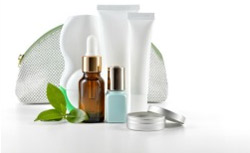 Most skincare products contain ingredients that have been packaged in a sterile environment where the containers were vacuum sealed and packaged to avoid tampering prior to use. These measures create safe topical treatments for at-home use, free of harmful bacteria or mold, and free of oxygen that accelerates the expiration of the product.
Most skincare products contain ingredients that have been packaged in a sterile environment where the containers were vacuum sealed and packaged to avoid tampering prior to use. These measures create safe topical treatments for at-home use, free of harmful bacteria or mold, and free of oxygen that accelerates the expiration of the product.
After a consumer opens the container, both the packaging and whatever it contains are exposed to a number of contaminants, including the users own skin cells. Because most skincare products will eventually spoil, manufacturers take other measures to ensure optimal consumer satisfaction. Printed on the labels, most often on the back of skincare product containers, is an opened container with the maximum number of months the product will remain fresh. The symbol below relays to the purchaser that the item can be used for 12 months after it is opened.
The expiration of skincare products are not regulated by the FDA. Cosmeceuticals are not government controlled. In order to assist all purchasers, chemists from skincare companies have created guidelines for individual product usage. There are also noticeable changes to the products over time. Their color, smell, or consistency may vary from when the skincare item was first used. Changes in any of these are a sign that the product may no longer be effective.
Specially Designed Containers
Often times, the material or color of a skincare item’s packaging will also promote freshness. Dark colored containers help to keep sunlight from penetrating the tube, pump container, or jar. Often, they are brown, glass bottles. Pump containers dispense product for a single use without the need to access the container. Some pump dispensers even separate ingredients that may react and spoil at an earlier time. Squeeze tubes offer another hygienic way to protect the contents of the tube while allowing the user more control over the amount they receive.
Storing Skincare Products
One way to ensure a product remains usable as long as possible is to use clean or disposable tools to remove the gel, serum, lotion, or cream from its container. A Q-tip can be used in jars or containers that do not dispense the product. Skincare items should also be stored in cool, dry drawers or cabinets to prevent the moisture and bacterial contaminants present in the typical bathroom. Keep all items away from heat and direct sunlight, even those packaged in sun proof bottles.
Some experts suggest refrigeration as another way to extend the life of your favorite skincare products. Check with your Aesthetician to see if this is appropriate for your products.
Checking External Sources for Product Expirations
Damage or removal of a label can inhibit a user from knowing when their skincare item may expire, which is why the Check Cosmetic website was created. Supporting a number of brands, this page explains how cosmetic and skin care brands can be searched by batch codes or lot numbers, which are typically printed directly on the container itself as opposed to the label. By knowing where to find these codes and what they mean, you can also contact manufacturers directly with any questions.
Ingredients’ Typical Expirations
Natural skincare products are often formulated without preserving ingredients, and thus tend to be especially vulnerable to expiring at a faster rate than other products. According to the Skin Medica website some ingredients like vitamins C and E are unstable, as are the additions of glycolic acid, retinol and hydroquinone. While most ingredients become less effective over time, glycolic acid and retinol can actually become more potent. Glycolic acid-soaked pads that are designed to fight acne are thought to expire after about two months, as they tend to dry out. Peels as masks with the same or similar ingredients remain effective for about three months. Retinoids tend to expire at the nine to eleven month mark.
Other acne-fighting ingredients like benzyl peroxide and salicylic acid tend to stay fresh for four to six months. If by this time you haven’t used all of the product, repurchase and refrigerate the containers to extend their usage.
Hydroquinone creams, or those that are designed to lighten areas of the skin, tend to become discolored after about two months of use, especially when overexposed to heat and air. Look for a brown hue to know it’s time to toss your cream.
Anti-aging creams are typically good for one year after they’ve been opened, though when formulated without these ingredients, the cream may last longer. Many emollient products follow the one year rule.
Consider these points a generalized guideline. Certain additives may impact the life of a product, which is why most labels are now designed with written or symbolic expiration dates.
The Office of Dr. Mark M. Hamilton, MD, FACS
Dr. Mark Hamilton performs non-surgical and surgical procedures for patients from all over the Midwest, Nationally and Internationally. Conveniently located in Carmel and Greenwood, Indiana, the doctor’s staff includes Licensed Medical Aestheticians. These experts work closely with the doctor to form treatment plans that suit each patient’s individual needs. Skincare products can be used alone, or in conjunction with surgical procedures such as facelift or mini facelift, or nonsurgical options like laser skin resurfacing or chemical peel for the most transformative results.
The Greenwood location can be reached at 317-859-3810, and the Carmel location at 800-597-3223. The staff is also available via email through the Contact Us form.
